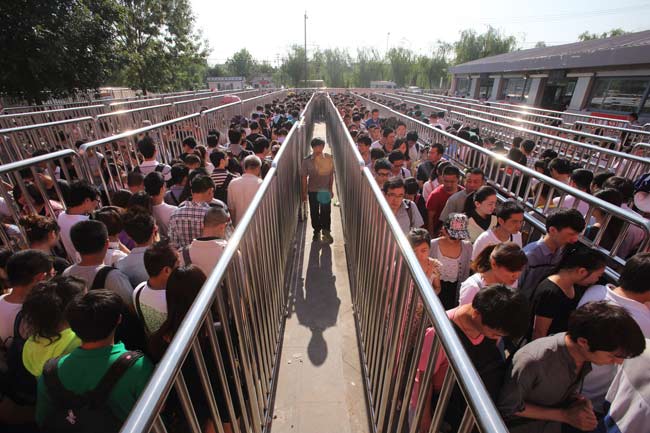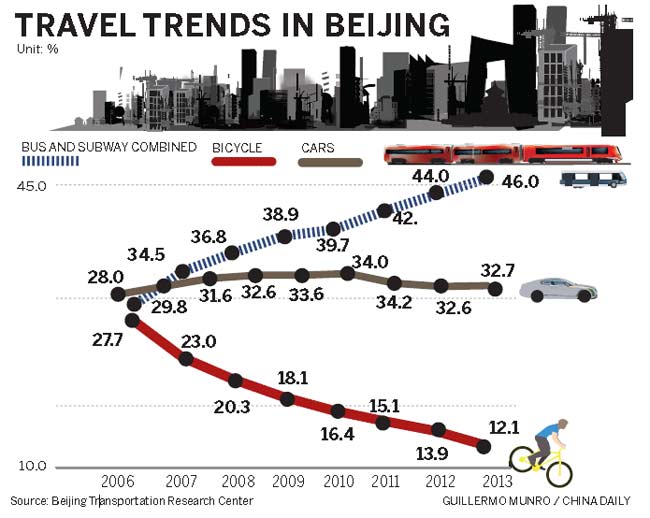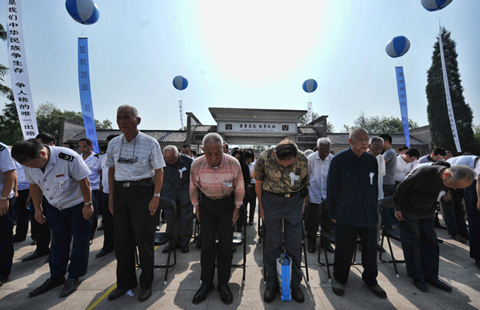Going the distance
Updated: 2014-09-11 07:12
By Zheng Jinran(China Daily)
|
|||||||||||
 |
|
People wait in long lines outside the Tiantongyuan subway station on an early morning in Beijing. Millions of people in the capital battle daily with rush hour through a strained public transport system. Despite increasing investment in the past decade, many say more needs to be done to satisfy travel demand. WANG JING / CHINA DAILY |
Capital's subways and buses strain to serve its fast-growing population, Zheng Jinran reports.
Beijing resident Shi Chao leaves home before 7 am and waits for the bus to take him to the subway station.
|
Raising safety awareness Commuters must enhance their safety awareness as subway usage increases, transport and security analysts said. Emergencies such as fires and natural disasters cannot be entirely avoided so it is important to ensure that every passenger avoids taking dangerous or hazardous items on trains and knows the location of exits, said Pei Yan, an associate professor specializing in subway security at People's Public Security University of China. Some subway passengers carry knives, which are not banned under Chinese law, but these items can be potential safety risks on public transport, Pei said. "Some people also take pets, including frogs and snakes, or goods with pungent smells, on subways. It's irresponsible because these things may arouse panic and result in disorder underground," she said. Safety and security might be compromised if such passengers continue their behavior, she said. "Relying solely on security devices is far from enough," she said. Guo Taisheng, another security specialist in the university, also suggested that passengers figure out escape routes once they take the subway or arrive at a new location. "It's vital for people to know where the safety exits are," he said. More subway staff are also needed to manage and control passenger flow, especially during rush hour, the analysts said. Signs pointing out the emergency exits must also be displayed prominently, they said. In recent months, security incidents including terrorist attacks in some railway stations have highlighted the importance of security in public transport. Beijing's subway system has adopted the strictest efforts to prevent potential security risks since July, operators said. By Cao Yin |
He then transfers from Line 1 to Line 10, passing 22 stations. The trip takes at least 50 minutes in a packed carriage where he can hardly move.
After that, it is another crowded bus ride in traffic jams before he reaches his office.
Shi's daily commute from his apartment outside the capital's West Fifth Ring Road to his company near the Northeast Fourth Ring Road takes him about two hours covering more than 50 kilometers.
The 28-year-old has been going through the ordeal since 2009, when he arrived in Beijing from his hometown in Shanxi province.
"It's quite common to wait for several subway carriages before I manage to squeeze into a spot on one of them," Shi said.
"Fortunately, I've got used to this daily 'long march'," he said, referring to the historic 10,000-km trek of the Chinese communists in their fight against the Nationalist forces.
Shi is just one of the millions of commuters in the Chinese capital who battle daily with rush hour through a fast-developing but increasingly strained public transport system.
Xu Fang, who lives in Yanjiao at the border area between Beijing and Hebei province, spends about two hours every day taking taxis and the subway to her office in the northeast of the capital, in the opposite direction of her home.
The 30-year-old has been making the trip to her company for the past few days.
But unlike Shi, she has had enough.
"I cannot bear another day like this. I'm moving to a place nearer my office," said the native of Sichuan province.
For Wang Pengfei, an insurance company employee, the many altercations between frustrated passengers on the packed subway have also become routine.
"I nearly suffocated once in the carriage and had to get out halfway to breathe properly," said the 29-year-old, recalling a day in 2011 when there was no air conditioning on the trains.
There have been an increasing number of stories about Beijing's crowded subways and public buses hitting the headlines.
At the Tiantongyuan and Huilongguan subway stations in the north, where residential communities are concentrated, more than 20,000 commuters flooded the stops in two hours, setting a record last November.
Many commuters in January reported spending more than 30 minutes before actually reaching the waiting area for the trains in the stations.
A report from Peking University showed that residents in Beijing spent the longest time commuting, about 1.32 hours a day for work on average in 2012, followed by residents in Shanghai and Tianjin, both traveling about 1.1 hours.
Coping with growth
Beijing, as the country's capital, was the first city to have a subway. Many believe the head start has also developed into the most comprehensive urban public transport network in China.
City authorities started planning for a subway system in 1953 and completed China's first metro Subway Line 1 - in 1969. By the end of 2013, the capital had 17 operating subway lines totaling 462 kilometers (excluding line S2), with 277 stations. Passenger capacity reached 3.2 billion in 2013, statistics from the Beijing Transportation Research Center showed.
Beijing's public bus network has also developed swiftly, making it one of the busiest urban transport systems in the country. By the end of 2013, the city had 785 bus lines, covering both downtown districts as well as suburban areas.
More than 4.63 billion passengers had taken the buses in 2013, based on a report from Beijing Public Transport Holdings, which is in charge of the major operation of the capital's ground public transportation system.
Though the combined annual passenger capacity for public buses has exceeded 7.8 billion, many say that is still not enough to satisfy travel demand. Complains about frequent traffic jams and overcrowded subways and buses continue to be hot topics among residents.
Beijing has also been growing larger with increasing pressure from the population. Its residential population has risen from 13.6 million in 2000 to 21.1 million in 2013. The flood of visitors during holidays has worsened the burden on public transport.
Since July 2013, the record passenger flow in a day has hit 11.05 million. Commuters were concentrated during the rush hours, accounting for 45 percent of the total every day, figures from the Beijing Subway Group showed.
In response, the municipal government released a document at the end of 2013 requiring the distribution of the pressure from rush hour.
 |
Today's Top News
China on right growth track: Davos founder
Risks rising in Europe: Chinese economist
Suspected Ebola case reported in Italy
Britain to send £1.6m arms to Iraq
Pessimism in ties with Japan
Apple unveils new phones, watch
Oxford University attests to power of the nation
Turkey in missile talks with France
Hot Topics
Lunar probe , China growth forecasts, Emission rules get tougher, China seen through 'colored lens', International board,
Editor's Picks

|

|

|

|

|

|





